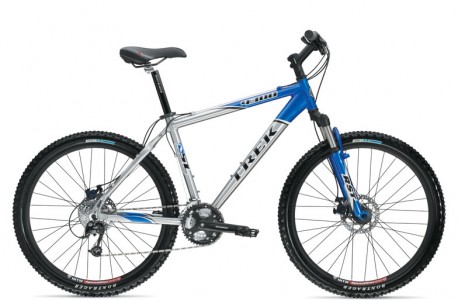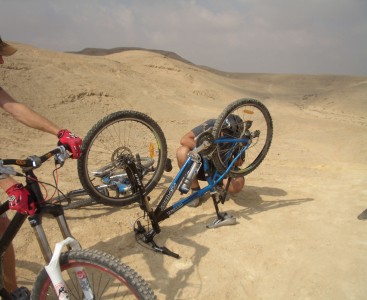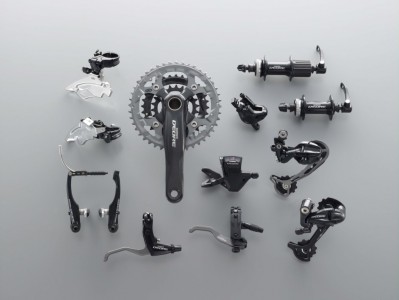Upgrading your entry-level mountain bike

A question I get asked a lot by people just getting into mountain biking is: What are the best upgrades I can make to my bike?
Simple enough question, but the answer would vary depending on rider experience, riding location and style, the type of bike you want to upgrade, among others. Thus, for the purpose of this article, I am going to assume the following:
- You are new (or relatively new) to mountain biking. You ride your bike on a regular basis and have ventured on the trails (i.e. Wadi Degla) at least a few times to have a general idea of what upgrades you would like to make.
- You have an entry level to- mid-range mountain bike, which is the type currently most prevalent in Egypt.
- You have a limited upgrade budget and would like to prioritize.
- Since this article is relevant to riding to Egypt I will also assume that you do most of your trail riding in Wadi Degla.
- You already have a decent frame: If you have a frame that is too heavy, too old, or otherwise in need of major repairs it is usually not worth it to go about starting with component upgrades. A good frame makes for a good platform for future upgrades and vice versa. To make the best out of your component upgrades, you should have a good frame to start with.
That said, you should keep in mind that this article focuses on upgrades that would make recreational mountain biking riding on a budget more enjoyable and components that strike a good balance between price and durability. We will leave talking about higher-end components aside for now for another article.
Step # 1: Know your bike
A typical mountain bike usually has 28-30+ individual components that can be grouped as follows:
1- The frame (the main chassis of your bike on which everything goes)
2- The Wheelset (wheels are made of rims, hubs, spokes, tires and tubes)
3- The drivetrain (front & rear derailleurs, chain, crankset, bottom bracket, pedals)
4- The brakes (brake levers, rotors, calipers, pads, cables/hoses)
5- The steering/cockpit group: (The handlebar, stem, grips, seat post, and saddle)
Step # 2: Prioritize:
If you are not able/can’t afford to get all the upgrades you need in one go, then you must prioritize. Start with the components that can make the most noticeable differences in the way your bike handles. Things like quality brakes, a good wheelset and a nice suspension fork will make for a much better mountain bike. If your drivetrain components are working fine, they should get lower upgrade priority until you start progressing into more frequent/aggressive riding or until they break. Cockpit and steering components should have the lowest priority since – for the average recreational rider – they do not make that much of a noticeable difference unless they are necessary for bike fit (such as stem length/ride and seat post setback).
Step # 3: Choose between durability and weight-savings:

Let me remind you that this article assumes you have a relatively limited budget for upgrades. If cost is a non-issue, then you shouldn’t be reading this.
As a general rule, you could only choose TWO of the following three component characteristics: Durable, light, cheap.
This means that if you get something that is both durable and cheap, chances are it will not be light. By the same token, if you decide to buy something that is both light and durable, you will be most probably paying a lot more on this specific component than others that would serve the same purpose but a little heavier. You can opt to get something which is light and cheap, but it probably won’t last very long. Trade-offs, trade-offs 🙂
Taking wheels as an example: Entry-level wheels bult on Shimano Deore hubs will not cost much, are pretty durable with moderate use and, but weigh in at around 2400+ grams for the wheelset (depending on rims and spokes). By comparison, mid-range wheelsets by Shimano, DT Swiss, Mavic and other well-known manufacturers will cost significantly more, but will be up to 600 grams lighter, have better hubs and are generally more durable. High-end wheels from the same manufacturers save yet more weight but retain the quality and durability, and look nicer, too! They also cost about 4 -5 times as much as entry level wheelsets. However, light-weight AND cheap wheels from lesser-known manufacturers suffer from quality and durability issues, but use the lighter weight as a selling point to compete with the bigger brands.
For beginner recreational riders, my advise would be to start with things that are both durable AND cheap. You want components that will both make a noticeable difference in the ride quality of your bike and that will last you for a good while before you decide to move up to higher-end items.
Step # 4: Check the interoperability of new/existing components:
Say you want to upgrade your suspension fork. You find a good deal on one and buy it. You’re getting ready to replace your old fork when you discover than your new fork does jot have v-brake bosses. You were not planning on upgrading to disc brakes now, especially since your wheels do not have disc hubs. Now you have to decide whether you want to return your new fork (if you can) and look for another one with v-brake mounts, or install it but do a whole bunch of expensive upgrades in order to use it (new hubs or wheels + a full disc brake set).
Step # 5: Don’t forget the accessories:
You might get too caught up in upgrading your bike and forget about other very important riding gear that will make a lot of difference in your ride quality and comfort. Make some room in your budget for a good hydration pack, quality gloves and shoes and some comfy riding shorts.
Some recommendations:
- Make sure that your components are properly installed and adjusted before deciding to upgrade. Many beginners make the mistake of assuming that some components are bad just becuase they’re not working properly. Drivetrain and suspension components need to be regularly and properly serviced and adjusted. Have some one with more experience check on things for you before you place an order for all-new equipment.
- Initially go for the mid-range, not the low-end: You probably already know that mountain biking is rough on frames and

The 2010 Shimano Deore mountain bike component group
components. Better components will last longer and generally require less maintenance. When buying on upgrading on a budget, try to get the components that fall in the mid-range of what manufacturers offer. For example, the Shimano Deore and SRAM x.5 and X.7 drivetrain groups are generally the most reasonable options for beginner mountain bikers who intend to get more into the sport. Components below this level will still work, but are lighter duty and not geared towards frequent/serious off-road riding. Higher-end components (e.g. Shimano Deore XT & XTR and SRAM X.9 and X.O) provide things like smoother shifting, lighter weight and better durability that you will only benefit from as your own riding progresses.